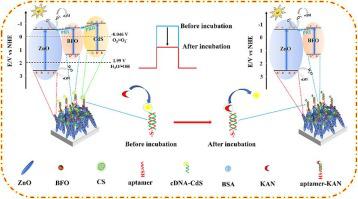当前位置:
X-MOL 学术
›
Food Chem.
›
论文详情
Our official English website, www.x-mol.net, welcomes your
feedback! (Note: you will need to create a separate account there.)
Synergistic effect of photoelectrochemical aptasensor based on staggered gap ZnO/BiFeO3 heterojunction coupled with cDNA-CdS sensitizer enabling ultrasensitive assay of kanamycin
Food Chemistry ( IF 8.5 ) Pub Date : 2023-10-26 , DOI: 10.1016/j.foodchem.2023.137877
Chuanze Zhong 1 , Cuizhong Zhang 2 , Ye Yang 1 , Xuexue Liang 1 , Qi Pang 1 , Liya Zhou 1 , Peican Chen 1
Food Chemistry ( IF 8.5 ) Pub Date : 2023-10-26 , DOI: 10.1016/j.foodchem.2023.137877
Chuanze Zhong 1 , Cuizhong Zhang 2 , Ye Yang 1 , Xuexue Liang 1 , Qi Pang 1 , Liya Zhou 1 , Peican Chen 1
Affiliation

|
Using staggered-gap ZnO/BiFeO3 heterojunction as photoactive materials and cDNA-CdS as the sensitizer for sensitive Kanamycin (KAN) detection, we have created a unique signal-off biosensing platform. The ZnO/BiFeO3 heterojunction provides active sites for aptamer loading and enhances photocurrent responsiveness. Rapid interfacial charge transfer and the separation efficiency of photo-generated carriers are enhanced by sensitization of the ternary heterojunction ZnO/BiFeO3 /CdS. Signal-amplified quenching occurs when sensitizers are replaced with sterically hindered KAN. Because of the aptamer's greater affinity for KAN, the replacement of CdS causes a decrease in photocurrent response. Additionally, the weakly conductive aptamer-KAN complex causes steric hindrance, which exacerbates the photoelectrochemical signal-damping effect even more. The photoelectrochemical aptasensor exhibits excellent selectivity and stability, detecting KAN within the range of 0.00005825–0.233 μg/mL with a detection limit of 0.0466 ng/mL (S/N = 3). This work demonstrates the potential of perovskite oxides and their heterostructures for advanced photoelectrochemical biosensing applications.
中文翻译:

基于交错间隙 ZnO/BiFeO3 异质结的光电化学适体传感器与 cDNA-CdS 敏化剂的协同作用可实现卡那霉素的超灵敏测定
使用交错间隙 ZnO/BiFeO3 异质结作为光活性材料,使用 cDNA-CdS 作为敏感卡那霉素 (KAN) 检测的敏化剂,我们创建了一个独特的信号关闭生物传感平台。ZnO/BiFeO3 异质结为适配体负载提供活性位点,并增强光电流响应性。通过三元异质结 ZnO/BiFeO3/CdS 的敏化,增强了快速界面电荷转移和光生载流子的分离效率。当敏化剂被空间位阻 KAN 取代时,会发生信号放大猝灭。由于适配体对 KAN 的亲和力更大,因此 CdS 的替代会导致光电流响应降低。此外,弱导电适配体-KAN 复合物会引起空间位阻,从而进一步加剧光电化学信号阻尼效应。光电化学适配体传感器表现出优异的选择性和稳定性,可检测 KAN 范围为 0.00005825–0.233 μg/mL,检测限为 0.0466 ng/mL (S/N = 3)。这项工作展示了钙钛矿氧化物及其异质结构在先进光电化学生物传感应用中的潜力。
更新日期:2023-10-26
中文翻译:

基于交错间隙 ZnO/BiFeO3 异质结的光电化学适体传感器与 cDNA-CdS 敏化剂的协同作用可实现卡那霉素的超灵敏测定
使用交错间隙 ZnO/BiFeO3 异质结作为光活性材料,使用 cDNA-CdS 作为敏感卡那霉素 (KAN) 检测的敏化剂,我们创建了一个独特的信号关闭生物传感平台。ZnO/BiFeO3 异质结为适配体负载提供活性位点,并增强光电流响应性。通过三元异质结 ZnO/BiFeO3/CdS 的敏化,增强了快速界面电荷转移和光生载流子的分离效率。当敏化剂被空间位阻 KAN 取代时,会发生信号放大猝灭。由于适配体对 KAN 的亲和力更大,因此 CdS 的替代会导致光电流响应降低。此外,弱导电适配体-KAN 复合物会引起空间位阻,从而进一步加剧光电化学信号阻尼效应。光电化学适配体传感器表现出优异的选择性和稳定性,可检测 KAN 范围为 0.00005825–0.233 μg/mL,检测限为 0.0466 ng/mL (S/N = 3)。这项工作展示了钙钛矿氧化物及其异质结构在先进光电化学生物传感应用中的潜力。

































 京公网安备 11010802027423号
京公网安备 11010802027423号